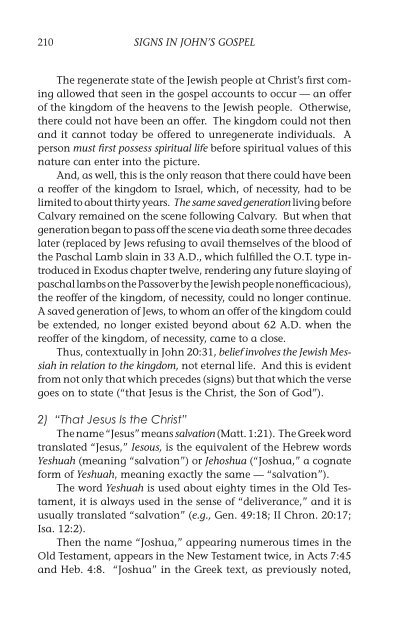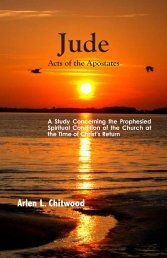Signs in John's Gospel - The Lamp Broadcast
Signs in John's Gospel - The Lamp Broadcast
Signs in John's Gospel - The Lamp Broadcast
You also want an ePaper? Increase the reach of your titles
YUMPU automatically turns print PDFs into web optimized ePapers that Google loves.
210 SIGNS IN JOHN’S GOSPEL<br />
<strong>The</strong> regenerate state of the Jewish people at Christ’s first com<strong>in</strong>g<br />
allowed that seen <strong>in</strong> the gospel accounts to occur — an offer<br />
of the k<strong>in</strong>gdom of the heavens to the Jewish people. Otherwise,<br />
there could not have been an offer. <strong>The</strong> k<strong>in</strong>gdom could not then<br />
and it cannot today be offered to unregenerate <strong>in</strong>dividuals. A<br />
person must first possess spiritual life before spiritual values of this<br />
nature can enter <strong>in</strong>to the picture.<br />
And, as well, this is the only reason that there could have been<br />
a reoffer of the k<strong>in</strong>gdom to Israel, which, of necessity, had to be<br />
limited to about thirty years. <strong>The</strong> same saved generation liv<strong>in</strong>g before<br />
Calvary rema<strong>in</strong>ed on the scene follow<strong>in</strong>g Calvary. But when that<br />
generation began to pass off the scene via death some three decades<br />
later (replaced by Jews refus<strong>in</strong>g to avail themselves of the blood of<br />
the Paschal Lamb sla<strong>in</strong> <strong>in</strong> 33 A.D., which fulfilled the O.T. type <strong>in</strong>troduced<br />
<strong>in</strong> Exodus chapter twelve, render<strong>in</strong>g any future slay<strong>in</strong>g of<br />
paschal lambs on the Passover by the Jewish people nonefficacious),<br />
the reoffer of the k<strong>in</strong>gdom, of necessity, could no longer cont<strong>in</strong>ue.<br />
A saved generation of Jews, to whom an offer of the k<strong>in</strong>gdom could<br />
be extended, no longer existed beyond about 62 A.D. when the<br />
reoffer of the k<strong>in</strong>gdom, of necessity, came to a close.<br />
Thus, contextually <strong>in</strong> John 20:31, belief <strong>in</strong>volves the Jewish Messiah<br />
<strong>in</strong> relation to the k<strong>in</strong>gdom, not eternal life. And this is evident<br />
from not only that which precedes (signs) but that which the verse<br />
goes on to state (“that Jesus is the Christ, the Son of God”).<br />
2) “That Jesus Is the Christ”<br />
<strong>The</strong> name “Jesus” means salvation (Matt. 1:21). <strong>The</strong> Greek word<br />
translated “Jesus,” Iesous, is the equivalent of the Hebrew words<br />
Yeshuah (mean<strong>in</strong>g “salvation”) or Jehoshua (“Joshua,” a cognate<br />
form of Yeshuah, mean<strong>in</strong>g exactly the same — “salvation”).<br />
<strong>The</strong> word Yeshuah is used about eighty times <strong>in</strong> the Old Testament,<br />
it is always used <strong>in</strong> the sense of “deliverance,” and it is<br />
usually translated “salvation” (e.g., Gen. 49:18; II Chron. 20:17;<br />
Isa. 12:2).<br />
<strong>The</strong>n the name “Joshua,” appear<strong>in</strong>g numerous times <strong>in</strong> the<br />
Old Testament, appears <strong>in</strong> the New Testament twice, <strong>in</strong> Acts 7:45<br />
and Heb. 4:8. “Joshua” <strong>in</strong> the Greek text, as previously noted,



